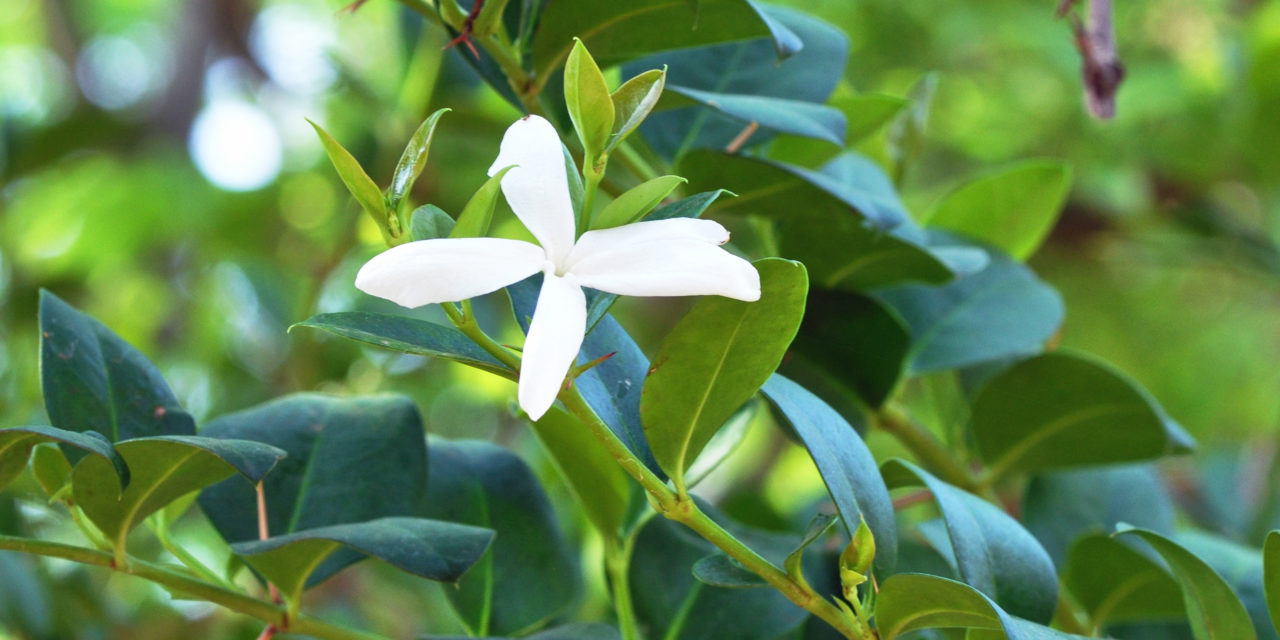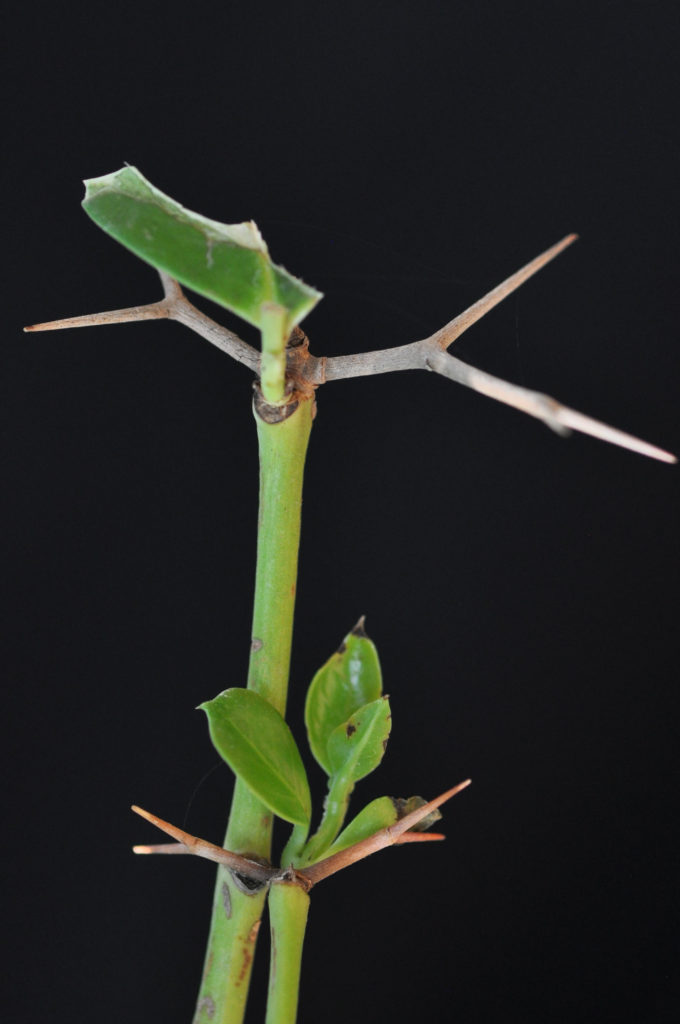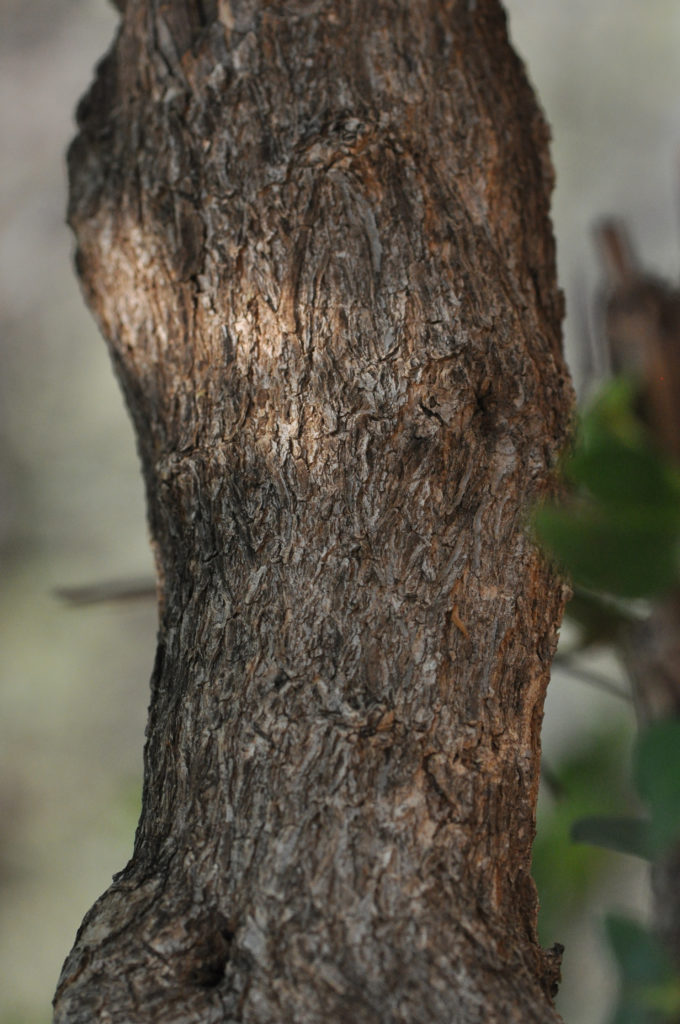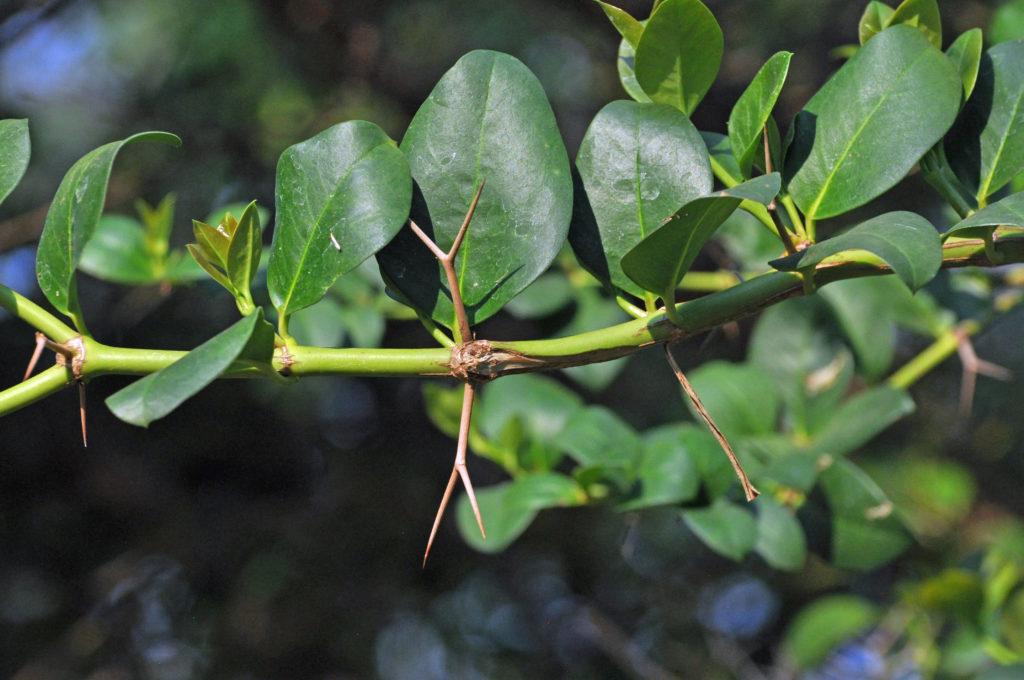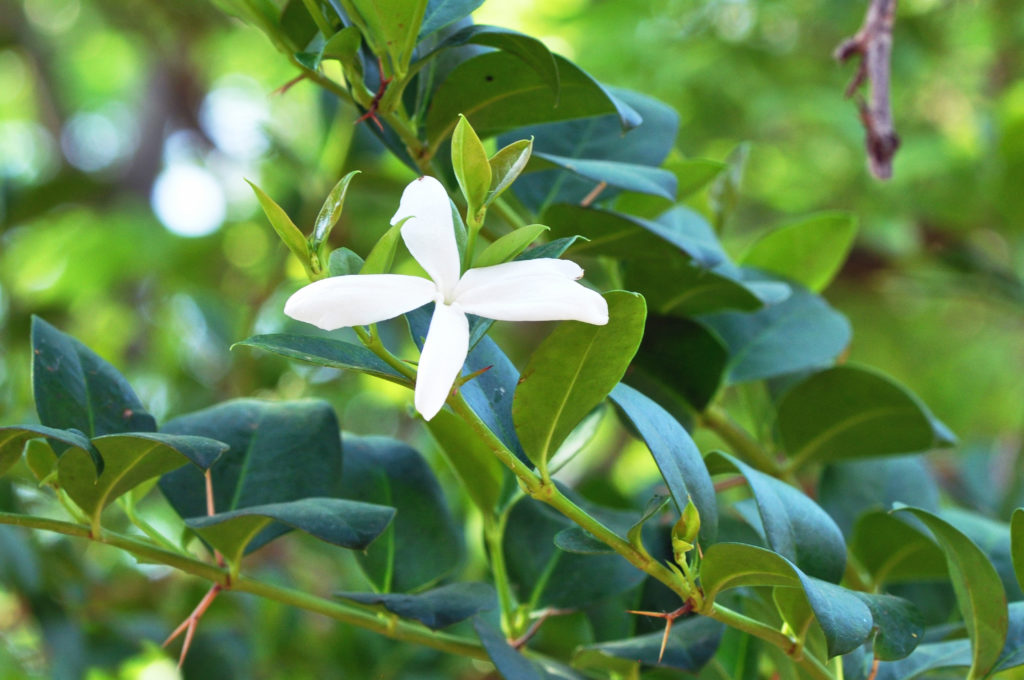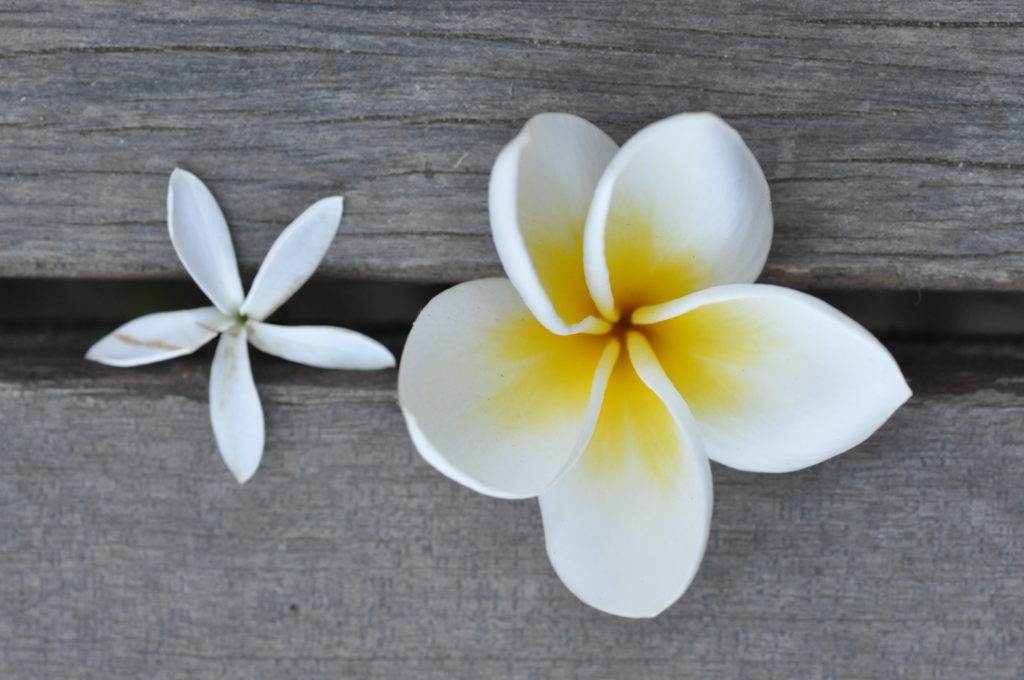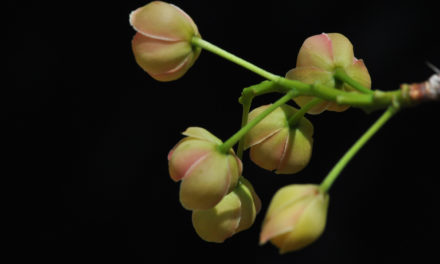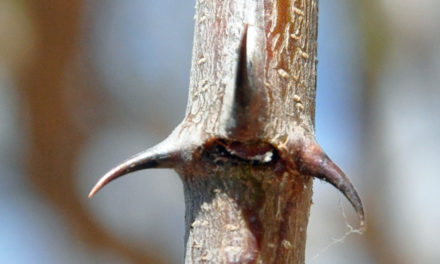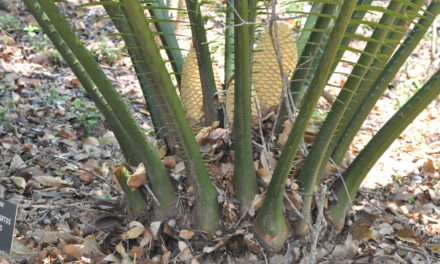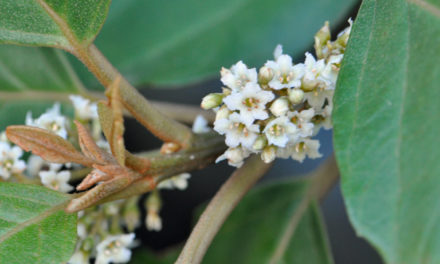General Info – summary
With its Y-shaped spines, this shrub or small evergreen Tree may reach 4m high. White non-toxic latex is present. Simple opposite Leaves with entire margins are hairless and up to 8 x 4cm. The distinctive, sweetly scented, regular, 5-merous, bisexual Flowers have a corolla with a cylindrical tube and imbricate white or pinkish petal lobes. This red, thin-skinned Fruit is a berry with one or two flat, irregularly shaped seeds.
Description
Carissa bispinosa
Previous Names: Carissa bispinosa var bispinosa, Carissa dinteri, Carissa haematocarpa, Carissa wyliei, Carissa bispinosa subsp. zambesiensis, Carissa bispinosa var. acuminate.
SA Tree No. 640.1, 640.5.
Common names: (Afr) Grootnoem-noem, Karoonoem-noem, Lemoenbessie, Lemoenbessieboom, Lemoenbessieboombos, Lemoenbessiebos, Lemoendoring, Noemnoem, Noem-noem, Noem-noembessie, Noem-noembess Niebos, Noem-noembos, Num-numbessie, Num-numbessiebos, Rooi Noem-noem. (Eng) Common Num-num, Fork-spined Carissa, Karoo Num-num, Karroo Num-num, Large Num-num, Noemnoem, Num-num, Red Num Num, Small Amatungulu, Y-thorned Carissa. (IsiNdebele) Umlugulu. (isiXhosa) Beta-umtumzi, Ibethamtunzi, Isibethankunzi, Isibethanku, Isivusankunzi. (isiZulu) Umvusankunzi. (Northern Sotho) Morokolo. (siSwati) umVusankunzi, umBethankunzi. (Setswana) Simboka. (Tshivenda) Murungulu. (Xitsonga) Mulu.
Family: Apocynaceae (Oleander or impala lily: Adenium multiflorum family). This family includes the exotic genera Oleander and Plumeria (Frangipani). Indigenous genera containing trees on this site include Acokanthera, Adenium, Carissa, Rauvolfia and Tabernaemontana. Currently the family has 366 genera and in excess of 5 000 species. In South Africa, there are 90 genera and about 700 species. All have milky or clear sap. The simple, entire and pinnately veined Leaves are usually opposite and may have stipules situated between the petiole and the stem. The Inflorescence is usually a cyme (a broad, more or less flat-topped, determinate flower cluster, with central flowers opening first). The regular and bisexual Flowers are usually bracteate. The Calyx has 4-5, usually free sepals and the 4-5 Petals are joined – at least at the base of the staminal column. A corona (an extension) is often present either on the corolla, or arising from the base of the staminal column. The 4-5 Stamens are variously located and have anthers with 2 pollen sacs. The superior to half-inferior Ovary has 2 carpels. Fruit is various. The often-compressed Seeds may have a tuft of silky hair at the micropylar end. The micropyle (a small opening in the surface of an ovule, through which the pollen tube penetrates) is often visible as a small pore in the ripe seed. During germination, the seedling’s radicle – embryonic root – emerges through the micropyle).
Name derivation: Carissa – from corissa – the name given to an Indian species of the same genus. The name is derived from Sanskrit (primary sacred language of Hinduism). bispinosa – 2-spined referring to the spines. There are 4 species of the genus Carissa in southern Africa.
Conservation: National Status: L C. Least Concern. Assessment: 2005 (W. Foden and L. Potter).
Tree
This plant is a shrub or small evergreen Tree. It is up to 4m high and is usually more or less the same width. The plant is usually densely twiggy, and a non-toxic white Latex is present. The initially green (photo 1021) and smooth Bark becomes greyish and wrinkled (photo 1024). Sharp, smooth, woody, stout, and equal paired Y-shaped, opposite Spines are present (photo 1021). The initially green and the persistent spines arise at the apex of shoots. They turn brown (photo 929 under Leaves) and are up to 4,5cm long.
- 1021 2016/09/12 Pilanesberg NP. Photo: David Becking.
- 1024 2016/09./12 Pilanesberg NP. Photo: David Becking.
Leaves
The hairless, opposite and often leathery Leaves are simple (have a single blade which may have incisions that are not deep enough to divide the blade into leaflets). They are ovate to circular and up to 8 x 4cm. The Apex is broadly tapering to rounded and may have a sharp tip. The Base is square, rounded or lobed. The Blade is dark, shiny green above and less so below (photo 929). Up to 8 pairs of Lateral veins are slightly visible below. The rolled under Margin is entire (with a continuous margin, not in any way indented). The Petiole (leaf stalk) is up to 3+ mm long with a grooved upper surface.
- 929 2016/09/11 Pilanesberg NP. Photo: David Becking.
Flowers
The white to pinkish, sweetly scented Flowers occur towards the ends of branchlets and appear conspicuous against the impressive dark green leaves. The bisexual flowers are up to 11mm long and actinomorphic (Regular, symmetrical. Flowers are vertically divisible into similar halves by more than 1 plane passing through the axis). Each flower (and fruit) has a short Pedicel (stalk of a single flower). The Calyx has 5 small Sepal lobes that are divided almost to the base. The Corolla has 5 Petals with a slender, cylindrical tube – up 10mm long. The 5 attached lobes are longer than the tube, each being up to 6mm long and less wide. Lobes are imbricate (having regularly arranged, overlapping edges, as roof tiles) and overlap each other to the left. This is easier to appreciate in the adjacent picture of Frangipani (Genus Pulmeria – photo – o7). Both these flowers are in the same family (Apocynaceae) and will rotate counter clockwise if a loosely held, picked flower is blown on from the top. The Carissa petals are hairy within. A disc (a more or less fleshy or elevated development of the receptacle) is absent. The linear-oblong Stamens are enclosed in the widened part of corolla tube and the short Filaments are slender. The Anthers are 4-locular (containing 4 chambers). The superior, entire Ovary contains 2 locules. The Style has a single truncate Stigma. Flowers and fruit often occur together. (Aug-Jan).
- 1014 2016/09/12 Pilanesberg NP. Photo: David Becking.
- 07 2018/06./23 Umngazi. Photo: David Becking.
Fruit
The almost spherical to oblong Fruit is a Berry (pulpy, indehiscent fruit like a grape or tomato). The berry is up to 1,5 x 0,6cm. The thinly skinned fruit turns from green to a glossy red when mature. Fruit and flowers may be visible at the same time. The 1-2 Seeds in each berry are flat and irregularly shaped. (Jan-Jun).
Distribution & Ecology
This plant occurs naturally in hot, dry areas like the bushveld, in coastal scrub and from low to medium altitude. This plant grows well in both sun and shade. In South Africa, it occurs in the Western Cape, Eastern Cape, KwaZulu-Natal, Gauteng, Mpumalanga, North West and Limpopo. It also occurs in siSwati (Swaziland), central and slightly northern Mozambique, Botswana, Namibia and northwards. The Flowers attract butterflies as well as other Insects. These, in turn, attract Birds. Game browse the Leaves. The leaves are one of the food plants for the Emperor Moth (Cirina forda) but its main food plant is Burkea africana. The Common Hawk moth (Nephele comma) feeds on these leaves as well as leaves of other Carissa species. This plant differs from Cassinopsis ilicifolia, which has single thorns and no latex.
Ethnobotany
This-fast growing plant can survive in a coastal environment. It can be cultivated from seeds. Plant seedlings about 1m apart to generate an evergreen barrier. They grow best in areas where the winters are mild. They can develop into an excellent protective hedge. Prostrate varieties are available. The tasty Fruits (including the milky sap) are edible and used to make good jam and jelly. Local medicine makes use of the roots.
References
Boon, R. 2010. Pooley’s Trees of eastern South Africa. Flora and Fauna Publications Trust, Durban.
Coates Palgrave, M. 2002. Keith Coates Palgrave Trees of Southern Africa, edn 3. Struik, Cape Town.
Foden, W. & Potter, L. 2005. Carissa bispinosa (L.) Desf. ex Brenan. National Assessment: Red List of South African Plants version 2020.1. Accessed on 2022/11/08.
Lawrence, G. H. M, 1951. Taxonomy of Vascular Plants, The Macmillan Company, New York. Tenth Printing 1965.
Palmer, E. & Pitman, N. 1972. Trees of southern Africa, Balkema, Amsterdam, Cape Town.
Schmidt, S. Lotter, M. & McCleland, W. 2002. Trees and Shrubs of Mpumalanga and the Kruger National Park.
van Wyk, B. & van Wyk, P. 1997 Field guide to Trees of Southern Africa, Struik, Cape Town.
http://www.plantzafrica.com/plantcd/carisbispin.htm
http://www.zimbabweflora.co.zw/speciesdata/species.php?species_id=144930
http://pza.sanbi.org/carissa-bispinosa
http://posa.sanbi.org/flora/browse.php?src=SP

